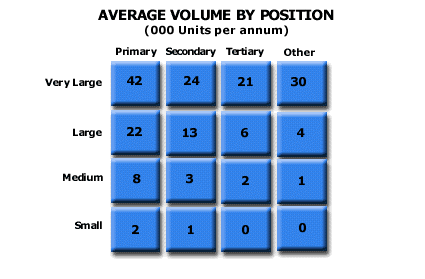BASIC STRATEGY GUIDE: STEP 5
Activity One (Steps 1-12):
Segment customers, both by size and by need, to identify targets for the Company.
Step 5: Estimate the average volume by position on the Size/Role matrix.

What:
Use the Size/Role matrix to show the amount of volume purchased by the average customer in each of the size segments on the matrix. Then, consider the growth and profitability of each position on the matrix. This analysis would project the Company’s specific profitability from the establishment of a new relationship with a new customer in one of the Size/Role segments. The analysis also considers broader changes in the market as a whole:
-
Larger customers tend to receive larger discounts than do the Medium and Small customers
-
The growth rate by size of customer may vary
-
The segment on the matrix may be growing or shrinking as the industry consolidates or de-consolidates its volume
-
Each segment on the matrix requires a unique cost-to-serve in order to meet the requirements for the role with the customer size
Why:
This analysis enables the Company to project the amount of volume it might expect from establishing a new relationship with a customer in one of the segments on the matrix. This step calculates the pay-off for the Company’s investment of marketing and sales expenditures to obtain new customer volume.
What to Watch For:
-
Customers of a given size (e.g., VL, L, M or S) at the end of a period (e.g., 3 years) may not have started the period at that size. Use the beginning of the period customer size to estimate the growth rate for a size category.
-
The company’s average sales volume results may not approximate those of the industry. If not, the company should understand why.
-
In a hostile market, the price spread within a customer size category may reach or exceed 30%. In such a market, the company must evaluate the profitability of each customer relationship.
-
In hostility, the company should know the unit prices at which customers in each position on the matrix (1) become unprofitable, and (2) fail to generate cash in their relationship with the company.
-
An industry may consolidate as Function and Price become less important in customers’ decisions. Function and Price purchase decisions often favor the industry’s smaller competitors. Customer purchases on Reliability and Convenience generally favor the larger suppliers in the industry.
Action:
Determine those positions that are attractive for the Company based on a combination of the segment’s profitability and the Company’s ability to meet the requirements of the segment.
-
Audio Tip #25: The Company’s Ability to Serve Size/Role Segments
-
Self Test #5: Serving Customer Segments on the Size/Role Matrix
-
Worksheet #5: Serving Customer Segments on the Size/Role Matrix
More Information on the Size/Role Matrix on the Advanced Site>>
More Information on Profitability of Segments on the Advanced Site>>
For helpful context on this step:
Videos:
-
Video #63: Core Customers Part 1: Defining Core, Near and Non-Core Customers
-
Video #64: Core Customers Part 2: Finding Core Customers in Your Marketplace
Perspectives:
Symptoms and Implications:

